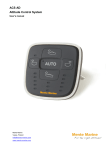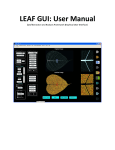Download Paper - NDT.net
Transcript
11th European Conference on Non-Destructive Testing (ECNDT 2014), October 6-10, 2014, Prague, Czech Republic Modern Mobile Systems for Diagnostics of Power Supply Facilities Vasiliy N. KOLTSOV1, Yury M. MIRONYUK2 1 Joint Venture “SEBA SPECTRUM” LLC, Bld.1, Usacheva St. 35, Moscow, 119048, Russia: + 7 495 2349161; [email protected] 2 Joint Venture “SEBA ENERGO” LLC, Bld. 16, Blk, 2, 2-y Kozhukhovskiy proyezd, 29, Moscow, 115342, Russia; [email protected] Abstract The presentation covers the issues related to diagnostics of power supply facilities and use of mobile diagnostic systems for their health monitoring. Classification of mobile laboratories used for low-, medium and highvoltage cable lines as well as for power substations is given. Description of new approaches in cable lines diagnostics is presented as well. Key words: Power cable lines, transformer substations, electrotechnical laboratories, diagnostics. 1. Introduction Economic development is incogitable without introduction of high-tech methods of production. Meanwhile, new powerful systems are increasing the load on the existing electrical networks. Their safe operation can be ensured by continuous health monitoring of the electrical equipment and timely problems solving. Electric power companies as well oil, gas and other industrial companies shall act immediately in case of equipment failures. In most cases, the production process and income as well as safety of people depend on how soon and accurate the specialists can reveal and eliminate detected faults in cable systems. As a rule, electrical equipment operates without any involvement of operators and maintenance personnel, dozens and hundreds of kilometers are rather far away from populated areas, where service companies are located. For example, it may be transformer substations, power cables and aerial (overhead) power lines. Failure of such equipment can not only create some inconvenience and problems, but also result in huge financial losses. That is why companies pay special attention to the level and completeness of equipment by choosing advanced and reliable one. Recently, many production companies pay special attention to mobile diagnostic systems (mobile electrotechnical laboratories - MEL). This fact can be easily explained. The use of such equipment provides urgent solution of the current problems and at the same time power supply facilities’ monitoring at minimal service costs. 2. General requirements to mobile diagnostic systems Mobile diagnostic systems (MEL) are generally mounted on a vehicle base (vans). As a result, they are safe, reliable, multifunctional, ergonomic and capable of servicing several production points. They can be operated in the most unfavourable conditions and if necessary ensure a no-break power supply. The choice of a vehicle to be used as base for MEL depends on operating conditions, weight and dimensional parameters of selected diagnostic equipment. The essential vehicle characteristics are engine power and off-road capacity. Cabling networks and substations may be located at places characterized by landscape not favorable for travelling. Potholes and uneven grounds beyond the auto track is an obvious Russian reality. The higher power parameters are the better is vehicle off-road capacity at complex routs and therefore enhanced laboratory and its components protection against mechanical impacts. Working conditions in MELs are thoroughly considered by specialists. A comfortable temperature and high-quality lighting are provided inside. Laboratories have air conditioning (Dometic), heating devices (Webasto), and quite powerful light sources. If necessary, the laboratory can be equipped with a self-sustained power supply system (SDMO petrol generators, Power Travel Martin System, etc.). Structurally the electrotechnical laboratory is usually divided into two compartments: the operator compartment and high voltage equipment compartment. They are separated by a transparent partition made of a special dielectric. The operator’ compartment is a workplace for a specialist which performs diagnostic work. Workplace ergonomics means simplicity and ease of control of existing equipment and measuring instruments. The compartment provides all conditions required to perform tests and produce resulting reports. There is a storage place for various “accessories” required for normal operator’s activity. All laboratory elements are thoroughly selected and constitute the best configuration for normal work. A person working in the laboratory cannot pay attention to many instruments, devices, buttons or keys at the same time and not to lose control over the situation that potentially constitutes threat to his/her life and/or the lives of colleagues. The high-voltage compartment contains equipment, constituting the risk of electric shock to the operator during measurement procedure. In this regard, a special attention is paid to electrical safety issues. These systems prevent operator’s access inside high-voltage compartment during equipment operation. For this reason, laboratory is equipped with sensors monitoring the high-voltage compartment door closing, emergency shutoff device, control of protective grounding and hazard potential on the chassis as well as audible and visual alarm. The electrical laboratory comes with two types of diagnostic equipment: basic and auxiliary. The first type includes stationary mounted instruments, and the second one – non-mounted instruments and devices (portable). These types of equipment provide result only when used as a package, so this classification may be called “conventional”. All instruments are adapted to the characteristics of the vehicle base in which they are installed in. They are safely and reliably fastened in the vehicle. Principle of modular configuration of the laboratory makes it possible to combine various diagnostic equipment and hence to produce MELs of different modifications to be used for testing and diagnostics of cables, substations electrical equipment, for preliminary localization and accurate detection of damaged places as well as for traces location and burial depth. In order to carry out diagnostics, testing and measurements, the MEL’ staff shall include at least two properly trained and certified specialists having the permit to work at power installations. 3. Mobile systems for cable line diagnostic Testing of cables by increased direct test voltage technique does not provide reliable information about the actual technical condition of power cable lines and can result in insulation breakdown for long time operating cable lines. Therefore, such tests are classified as destroying cable line insulation. In recent years, intensive research have been carried out in order to develop and implement effective and gentle, nondestructive methods of power cable line on-line diagnostics, which do not put load on cable line insulation, unlike direct voltage tests. At present, the following non-destructive methods of cable line diagnostic are widely used: Complex test at extremely low frequencies 0.1Hz and at voltage of up to 54kV, which allows medium-voltage cables testing in a gentle mode and is particularly suitable for cables with cross-linked polyethylene insulation. Pulse reflectometry method for preliminary localization of low-resistance faults in power cable lines (using Teleflex reflectometer) and pulsed arc method for preliminary localization of high-resistance faults in cable lines (using reflectometer and arc stabilization device). Method for cable lines integrity monitoring and sheaths damage localization (using MFM 5-1, MVG 5 and other instruments). Introduction of non-destructive methods for power cable line diagnostics with the help of modern diagnostic equipment makes it possible to evaluate the condition of insulation and detect problem areas in cable lines without insulation damaging; to make well-founded decision relevant to further operation or time for replacement of cables with expired service life and to schedule cable lines repairs in a rational and reasonable manner. 3.1. CLASSIC electric laboratory for testing and localization of power line faults in low and medium voltage networks The electrotechnical laboratory is equipped with the Classic System, which offers the possibility of maximum varying of the laboratory configuration. One can choose between two central panels of network switching for modular system management: - Manual central control by plug switch - Convenient central control via automatic switching panel and connection of individual instruments via a high-voltage gas-insulated switch. Both panels maintain automatic control over the mains supply and laboratory safety system. The Classic System flexibility (see Fig. 1) allows to concord customers’ requirements with the parameters for cable testing, pulse energy for accurate localization, burning function and search for sheath damages. The Classic System provides use of the following testing methods and localization of cable line faults: - Cable line testing (DC, AC, VLF), - Preliminary fault localization technique (ARM, ICE, Decay, IFL), - Accurate methods (acoustic, sound, step voltage) - Damaged sheath localization. Fig. 1. 3.2. CENTRIX electrotechnical laboratory for testing and localization of power line faults in low and medium voltage networks The unique electrical laboratory equipped with the Centrix system was developed in collaboration with customers (Fig. 2) and is based on their requirements and experience of daily work with available equipment. All this gave rise to the electrical system which sets new standards in problems solving: - user-friendly, efficient - technique of preliminary localization ARM up to 80 kV, ARM-slide technology - automatic analysis of the measurement results, report in the PDF format - on-line documentation and help function All standard processes are run with a single button. The user may fully concentrate on damages revealing. The control of Centrix Troubleshooting System includes large monitor and a randomly located control panel. The last one includes a central control element of the system - Jogdial. The Linux® based operating system is very stable. It automatically saves all measurement results and allows flexible implementation of analysis and data transfer. Jogdial is used to control all system functions. In addition, Jogdial provides direct on-line access to user manual, measurements data base, phase selection option and shortcut menu. Centrix system provides preliminary selection of control operations sequence. Due to such approach in most cases next step is activated by simple confirmation. Fig. 2. 3.3. CITY electrotechnical laboratory for testing and localization of power line faults in low and medium voltage networks This MEL is specially designed for the urban environment and equipped with a mobile system for cable testing and fault location. SPG 40 is a mobile, multi-function unit for testing, transformation, preliminary and accurate localization of cable faults in networks of low and medium voltage (Fig. 3). The system is controlled via connected a T 30-E reflectometer or integrated control panel. Depending on modification use is made of integrated control block to choose between line or high voltage or of separate high voltage control unit. All system functions are controlled via rotating knob. The software provides simple and visual control, thus supporting inexperienced users. Furthermore, the maximum operation safety is ensured. Fig. 3. 3.4. Electrotechnical laboratory for diagnostics of high voltage cable lines At present the following NDT methods of cable line diagnostics are most widely used: Technique of measurement and localization of partial discharge in power cable lines (it based on the OWTS diagnostic system). OWTS (Oszillating Wave Teilentladungs System) for each cable section gives information about partial discharge level, partial discharge ignition and extinction voltage as well as localization of damaged areas generating partial discharge. This information is used for cable condition evaluation and recommendations for its further use. Technique of measurement and analysis of the return voltage in power cables insulation (it based on the the CDS Diagnostic System). As a result of such dielectric diagnostic use provides an integral evaluation of cables with impregnated paper insulation humidity. In this case the following classes’ classification is used: "dry", "slightly moist", "moist" and " wet ". It helps to estimate operating reliability and make recommendations for further operation or taking any measures related to the cable. The analysis of the charging current measurements allows to recognize indications of moist couplings. Technique of relaxation current measurement in cable insulation made of cross-linked polyethylene (it based on the KDA- 1 and CDS diagnostic system). The result of such dielectric diagnostics of PE/VPE cables is classification of the last ones in accordance with following groups: "new", "aged", "old" or "critical". Additionally, a forecast of a typical residual electrical current strength of the actual object under measurements is given based on comparison of current measurement results with ones from data bank obtained experimentally. Technique of measurement of cable insulation dielectric characteristics (it based on the OWTS diagnostic systems). The electrotechnical laboratory is equipped with all necessary equipment to implement all of the above diagnostic technique (Fig. 4). Fig. 4. 4. Mobile systems for substation equipment diagnostics The ASTRA electrotechnical laboratory is designed for high-voltage transformers diagnostics and a range of works on power transformer testing and diagnostics according to the regulatory list of power transformers tests "Scope and Standards for Electrical Equipment Testing" during commissioning and operation (Fig. 5): measurement of equipment insulation parameters; measurement of equipment contacts and transformer winding resistance; measurement of power transformer idle losses; measurement of power transformer short-circuit impedance; transformer CT ratio test; transformer vector group test; test of equipment insulation by increased industrial frequency voltage; test of equipment insulation by increased rectified voltage. Fig. 5. The hardware and software complex with a single control of the total measurement system helps to solve tasks that previously were impossible to solve during testing and diagnostic. The software serving the universal control module, registers measurement results. At the end of each measurement results are automatically transferred via communication interface to the tables and visualized. The software calculates the deviation between the measured values, compares the measured results with the passport data and previous tests data. The ASTRA MEL efficiently provides collecting of highly reliable results of a comprehensive examination of power transformers and this is of particular importance for their trouble-free operation as well as for timely replacement or repair. Photo 5. Conclusions The economic benefit from the use of mobile electrotechnical laboratories is obvious. The laboratory can be used for almost any comprehensive diagnostics of equipment, without the need of its delivery to a diagnostic center; it helps identify faults in equipment operation and timely perform repair or replacement. At the same time, it reduces transport costs twice as compared to the fixed-site laboratory, since after examination the equipment has to be delivered back. It reduces the number of equipment failures and, accordingly, losses associated with such a failures.


























